What does psoriasis look like?
Psoriasis typically appears as a red, dry, and flaky patch of skin, and may be covered with white scales called plaques. It can occur on any area of the body, including hands, feet, elbows, scalp or genitals. Frequent itching can lead to thicker areas of plaques.
Psoriasis can feel itchy, sore, burning and the skin may be tight, crack or bleed. There are several different types of psoriasis, and some may even occur at the same time.
Types of psoriasis
- Plaque psoriasis
- Guttate psoriasis
- Scalp psoriasis
- Pustular psoriasis
- Inverse psoriasis
- Nail psoriasis
- Erythrodermic psoriasis
- Psoriatic Arthritis
Plaque psoriasis: This is the most common type of psoriasis. About 80% to 90% of people diagnosed with psoriasis will have plaque psoriasis. Skin patches may become red, inflamed, dry, and flaky and may be covered with white scales called plaques. It can occur on any body area, but frequently affects the hands, feet, elbows, scalp or genitals.
The skin in plaque psoriasis may be itchy, sore, burning or feel tight. Frequent itching can lead to thicker areas of plaques, and it may crack or bleed. It usually goes through a cycle of symptoms, with flares lasting a few weeks or months. It then may quiet down for a time and may even go into remission where symptoms subside completely.
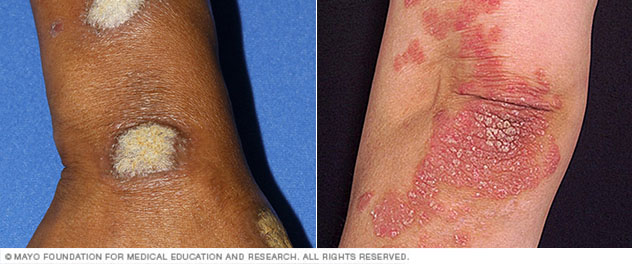
Guttate Psoriasis: This type may appear as reddened, raised, pea-sized plaques, often on the midsection of the body. The lesions may be covered by a fine scale. Guttate psoriasis may be more common in children or adults under 30 years of age who have a past history of streptococcal infection (strep throat) or an upper respiratory viral infection. About 8% of people diagnosed with psoriasis have guttate psoriasis.
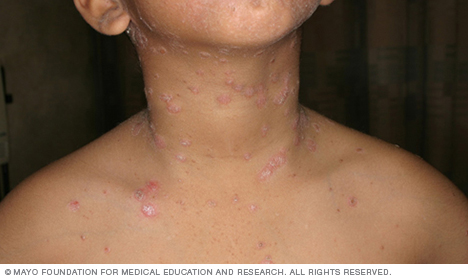
Scalp psoriasis: This common form of psoriasis leads to reddened patches with silvery scales on the scalp, often extending just beside the hairline. A thick crust may develop and it may bleed. Scalp psoriasis can affect the entire scalp or smaller patches, the neck and behind the ears. Scalp psoriasis is often plaque psoriasis. Roughly 50% of the people diagnosed with psoriasis have scalp psoriasis. Scalp psoriasis and psoriatic arthritis often occur together.
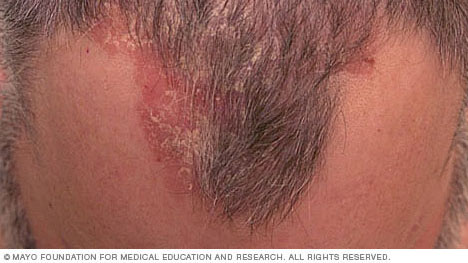
Pustular psoriasis: This is a rare but often painful and severe form of psoriasis. Pus-filled sacs (pustules) that may break open or pimples appear on the skin. The lesions can be widespread or confined to smaller areas like the feet, hands or fingertips. Fever may occur. About 3% of those with psoriasis have pustular psoriasis.
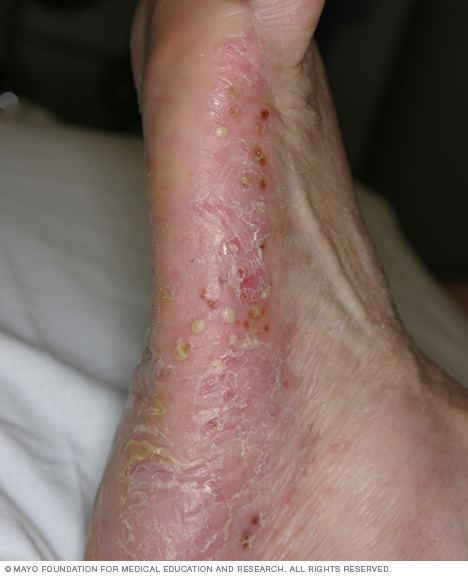
Inverse Psoriasis: This type of psoriasis can affect moist, skin crease areas such as the genital area, under the breast or arms, and the groin area. The lesions are flat, red and inflamed, and may not have scales. Inverse psoriasis may be more common in people that are overweight or obese, and can be worsened by friction and sweating. Candida (yeast) infections may be present. This type occurs in about 20% to 30% of people diagnosed with psoriasis.
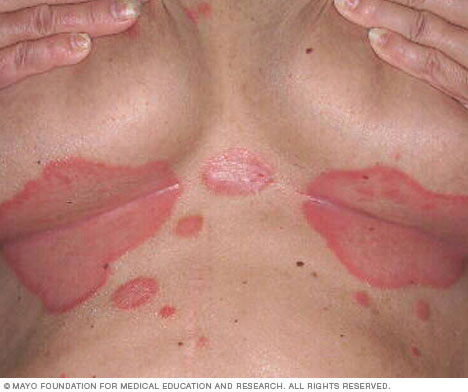
Nail Psoriasis: Fingernails and toenails may become yellow-brown, pitted, flake away or detach from the nail bed. Nail psoriasis may occur in about 50% of people with psoriasis.
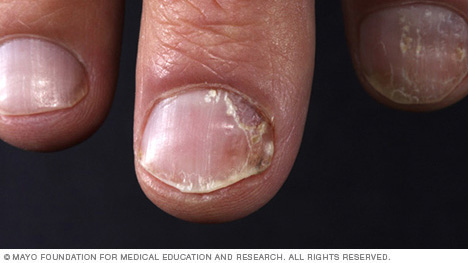
Erythrodermic psoriasis: This is the least common type of psoriasis, but can be severe and life-threatening. Erythrodermic psoriasis can cover your entire body with a red, peeling rash that can itch or burn intensely. Your body temperature can change and extreme swelling may occur. This type of psoriasis is rare, affecting roughly 2% of people diagnosed with psoriasis
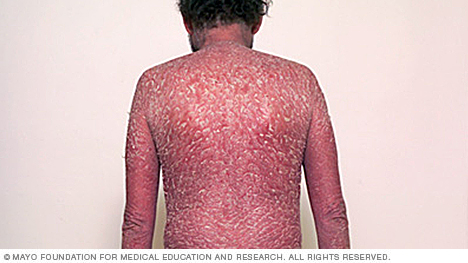
Psoriatic Arthritis: May occur in up to 30% of patients with psoriasis; symptoms include swelling of the knees, ankles, hands and toe joints; pain; and may be accompanied by nail psoriasis. Psoriatic arthritis may start before skin changes are seen. It can affect any joint.
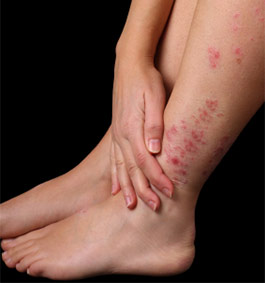
Related Questions
- How do you get psoriasis and is it contagious?
- How does Tremfya work to treat plaque and psoriatic arthritis?
- How does Ilumya work to treat psoriasis?
Treatment
Treatment of psoriasis can improve the appearance of your skin and may make you feel less self-conscious. See your doctor for an evaluation if you think you have developed this common skin condition. Today, there are many options for treatment, including:
- Topicals (such as creams, lotions, ointment and solutions)
- Phototherapy (light therapy)
- Oral medicines
- Injected medicines
- Biologics, which may be injected or taken by mouth
Learn More: What are the new drugs for the treatment of plaque psoriasis?
References
- Psoriatic arthritis. Mayo Clinic Disease Reference. Drugs.com. Accessed Dec. 8, 2021 at https://www.drugs.com/mcd/psoriatic-arthritis
- National Psoriasis Foundation. About psoriasis. Accessed Dec. 8, 2021 at https://www.psoriasis.org/
Read next
Related medical questions
- What are the new drugs for plaque psoriasis?
- Is triamcinolone acetonide an antifungal cream?
- How do you use clobetasol propionate on your scalp?
- Clobetasol vs. triamcinolone - how do they compare?
- What is a substitute for fluocinonide cream?
- How long does methotrexate stay in your system?
- Halobetasol vs. clobetasol - How do they compare?
- Does taking vitamin D help with psoriasis?
- What causes Plaque Psoriasis?
- Sotyktu vs Otezla: How do they compare?
- Can clobetasol be used for toenail fungus?
- How does Taltz compare to Cosentyx for psoriatic arthritis?
- How long does it take for Skyrizi to work?
- Is fluocinonide an antifungal cream?
- How long should you use fluocinonide for?
- How do you inject Humira?
- How long does clobetasol stay in your system?
- Does Feverfew interact with any drugs?
- Cosentyx vs Humira: How do they compare?
- Who is the actress in the Stelara commercial?
- What's the dosing schedule for Skyrizi?
- What happens if Cosentyx is not refrigerated?
- How long does it take for Sotyktu to work?
- Can Enstilar be used on the scalp?
- What is the mechanism of action of infliximab?
- What is fluocinonide cream good for?
- Does Cosentyx cause weight gain or loss?
- Does Skyrizi cause cancer?
- How long does it take for Tremfya to work?
- Does Luxiq Foam help with hair loss?
Related support groups
- Psoriasis (97 questions, 305 members)
